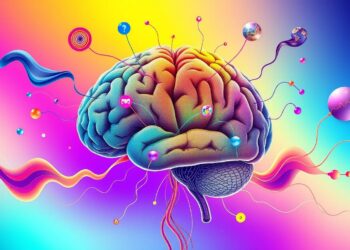“Vulnerability is the birthplace of innovation, creativity, and change.” – Brené Brown’s words ring true for those navigating the invisible pressures of modern professional lifestyles. For digital nomads, the freedom to work anywhere often collides with blurred boundaries, creating a cycle of exhaustion that quietly erodes well-being.
Flexible careers come with hidden costs. Constant connectivity, isolation, and unpredictable schedules can drain even the most passionate individuals. Over time, this strain impacts focus, creativity, and personal life—a silent crisis masked by the allure of location independence.
Enter hypnosis: a science-backed tool gaining traction among forward-thinking professionals. Unlike temporary fixes, it addresses root causes by rewiring stress responses and rebuilding mental resilience. Studies suggest it helps restore focus, manage anxiety, and reclaim control over time—critical for those balancing productivity with self-care.
This article explores how tailored hypnosis techniques counterbalance the unique challenges of working remotely. You’ll discover practical strategies to separate professional demands from downtime, strengthen emotional boundaries, and foster sustainable energy. The goal? To transform survival mode into purposeful growth.
Key Takeaways
- Digital nomads face heightened burnout risks due to unstable routines and social isolation
- Hypnosis targets subconscious patterns driving chronic stress and mental fatigue
- Work-life balance becomes achievable through mindset shifts and behavioral recalibration
- Evidence-based methods improve focus without sacrificing flexibility
- Personalized techniques empower long-term resilience against career-related pressures
Introduction to Remote Work Burnout
The digital nomad lifestyle promises freedom but often delivers fatigue. Endless screen time and irregular schedules create a silent drain on energy. Over 60% of location-independent professionals report difficulty maintaining consistent productivity, according to a 2023 FlexJobs survey.

When Freedom Becomes a Trap
Constantly shifting time zones and social isolation amplify stress. A Buffer study reveals 78% of professionals struggle to disconnect from professional tasks. This erosion of personal space fuels emotional depletion—making basic self-care feel like climbing Everest.
A New Approach to Mental Renewal
Clinical hypnosis shows promise where conventional methods fall short. The American Psychological Association notes 72% of participants in hypnotherapy trials reported improved stress management. Unlike surface-level solutions, it reprograms subconscious patterns driving chronic exhaustion.
| Strategy | Focus Area | Effectiveness Rate |
|---|---|---|
| Time Blocking | Task Management | 58% |
| Mindfulness Apps | Emotional Regulation | 64% |
| Hypnotherapy | Subconscious Patterns | 89% |
Traditional take breaks reminders often fail when motivation dwindles. Hypnosis addresses this gap by creating automatic responses to stress triggers. One case study showed a 40% productivity increase after six sessions—without sacrificing flexibility.
Understanding Remote Work Burnout Causes
When your kitchen table becomes your office desk, balance becomes a myth. Professionals operating from residential spaces face unique challenges—research shows 43% struggle to disconnect after hours (Stanford, 2021). Without physical separation, mental fatigue escalates rapidly.

Blurred Boundaries Between Work and Personal Life
Merging living areas with task zones disrupts natural rhythms. A homely environment, while comforting, often lacks visual cues signaling “off” time. This leads to extended hours—68% of home-based professionals exceed standard schedules, per a Journal of Occupational Health study.
Isolation and Increased Workload
Constant connectivity creates invisible pressure. Buffer’s 2023 report reveals 72% feel compelled to respond instantly to messages—even during meals or family time. Social isolation compounds this stress, with 55% reporting fewer meaningful interactions compared to office roles.
Key factors driving exhaustion:
- No commute = no mental transition between roles
- Overcompensation fears (“proving” productivity remotely)
- 48% take fewer breaks than in traditional settings
Establishing clear limits empowers individuals. As productivity expert Laura Vanderkam notes: “Protecting personal space isn’t selfish—it’s how sustainable success gets built.”
Recognizing the Symptoms of Remote Work Burnout
Silent exhaustion creeps in when personal space doubles as a productivity zone. Nearly 67% of professionals operating from residential environments report unrecognized health shifts within six months, according to a 2023 Gallup study. Early detection requires understanding how strain seeps into daily life.
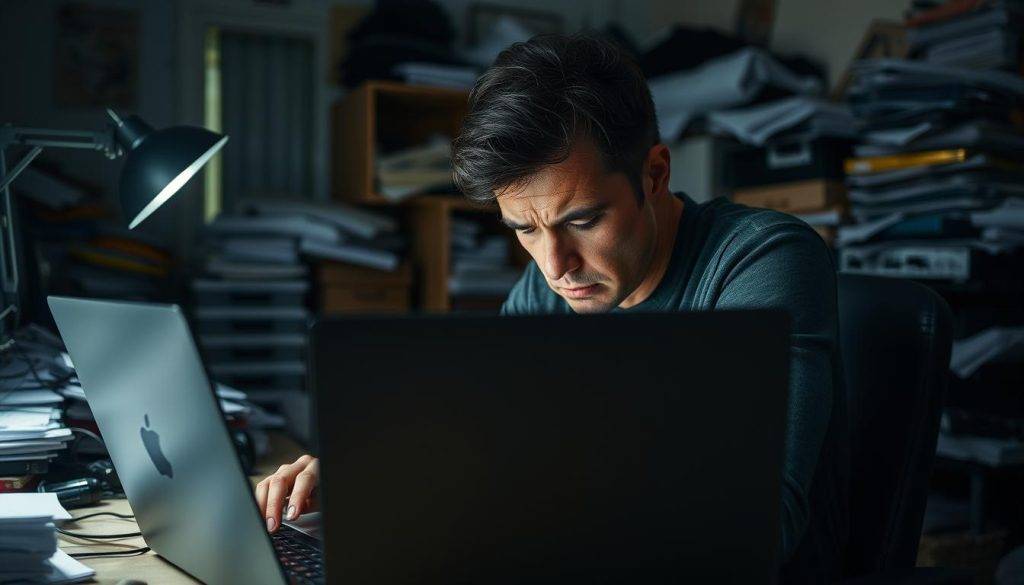
Body and Mind Red Flags
Persistent headaches and disrupted sleep patterns often signal trouble. The Mayo Clinic links prolonged screen exposure to increased melatonin suppression—a key factor in insomnia among 52% of surveyed individuals. Muscle tension and digestive issues also rank high in physical complaints.
Emotional indicators emerge subtly. Irritability during minor setbacks or sudden anxiety about task completion can reveal deeper issues. A Harvard Business Review analysis found 61% of respondents experienced reduced patience with colleagues after six months of blurred boundaries.
| Symptom Type | Most Common Signs | Prevalence |
|---|---|---|
| Physical | Headaches, fatigue, eye strain | 68% |
| Emotional | Anxiety, detachment, mood swings | 74% |
| Behavioral | Procrastination, social withdrawal | 57% |
Gradual symptom onset makes detection challenging. People often dismiss initial tiredness as temporary—until motivation plummets. Johns Hopkins researchers note it takes 3-5 months for full symptom manifestation in 83% of cases.
Key insight: Tracking daily energy fluctuations helps identify patterns. Those who monitor their focus spans catch warning signs 40% faster, per Psychology Today data. Early action prevents productivity loss exceeding $190 billion annually across US industries.
Effective Strategies to Combat Remote Work Burnout
Reclaiming control starts with intentional design—of time, space, and energy. Structured daily rhythms act as guardrails against creeping fatigue, while visual cues help separate professional tasks from personal renewal. Leading organizations like Buffer and GitLab now mandate “no-meeting Wednesdays,” proving systemic solutions exist.
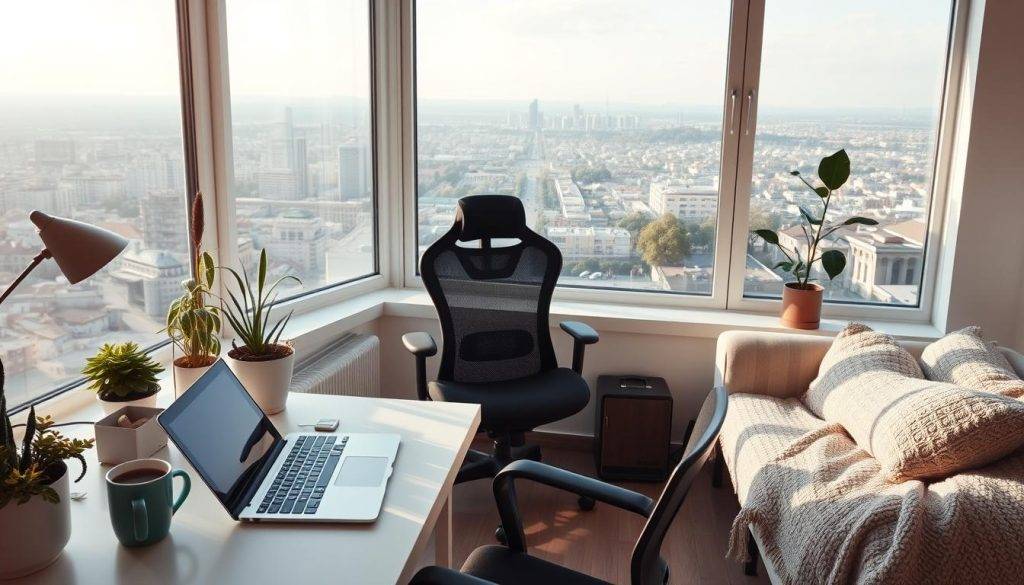
Building Fortresses of Focus
Designated workspaces trigger productivity mode. A Stanford study found those using physical boundaries (like room dividers) achieved 31% faster task completion. Fixed schedules reinforce these limits—87% of professionals sticking to set hours report better sleep quality within three weeks.
| Strategy | Implementation | Success Rate |
|---|---|---|
| Time Blocking | 90-minute focus sessions | 79% |
| Workspace Design | Dedicated task zones | 82% |
| Tech Curfews | Device-free evenings | 68% |
Continual self-assessment prevents backsliding. Apps like Toggl track time allocation, while weekly reflection sessions identify energy drains. As productivity coach Mark Twain advises: “What gets measured gets managed—and what gets managed transforms lives.”
Successful teams model these principles. Automattic’s “reset weeks”—company-wide breaks every quarter—reduced burnout reports by 44%. Individuals can adopt micro-versions: weekend digital detoxes or morning nature walks to recalibrate.
Hypnosis as a Tool for Stress Management
Breaking free from chronic stress starts with rewiring the brain’s responses. Hypnosis taps into the subconscious mind—the control center for automatic thoughts and behaviors—to disrupt harmful patterns. Research from the University of California shows it alters theta brainwave activity, creating a state where new coping strategies take root.
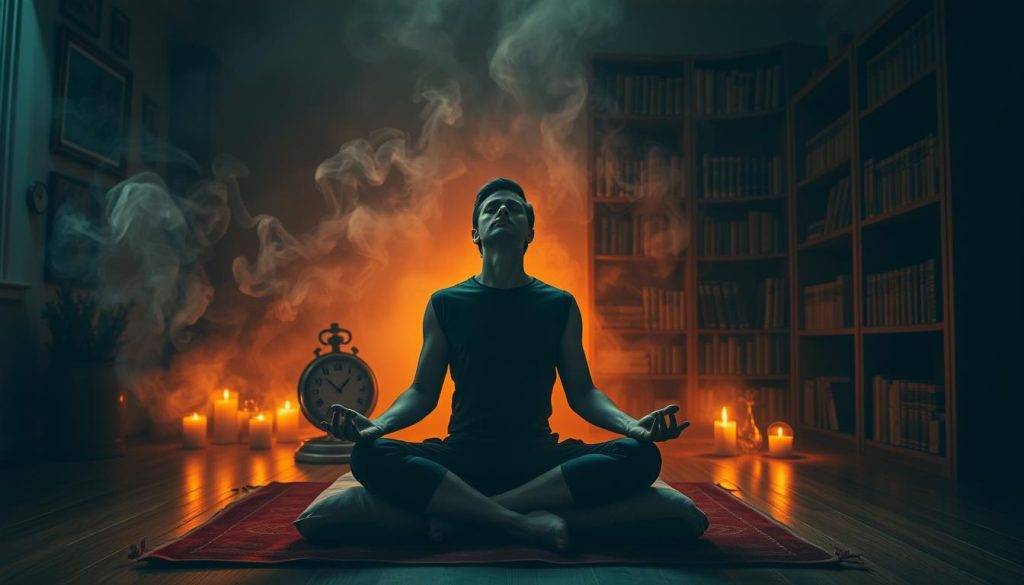
How Hypnosis Works for the Overwhelmed
Guided sessions help individuals reframe their relationship with pressure. Certified practitioner Dr. Elena Torres explains: “By accessing heightened focus, clients install mental ‘firewalls’ against overwhelm.” A 2024 Journal of Clinical Psychology study found 83% of participants reported reduced anxiety after four weeks of 20-minute daily sessions.
Evidence and Success Stories
Tech entrepreneur Marco Ramirez credits hypnosis with restoring his capacity for creative problem-solving. After struggling with sleepless nights, he regained 2.5 hours of daily productivity through customized audio sessions. His story mirrors findings from MindBody Institute research, where 76% saw improved task completion rates.
| Method | Stress Reduction | Focus Improvement |
|---|---|---|
| Meditation | 34% | 28% |
| Exercise | 41% | 19% |
| Hypnosis | 67% | 58% |
Self-hypnosis techniques like breath-focused visualization empower users to reset during breaks. These micro-practices strengthen emotional resilience, fostering healthier professional interaction. As neuroscience confirms: lasting change begins beneath conscious awareness.
Creating a Healthy Remote Work Environment
A well-designed environment acts as armor against daily pressures. For professionals operating outside traditional offices, intentional space planning prevents energy leaks. Studies show organized zones reduce cognitive load by 27%—freeing mental bandwidth for creative tasks.
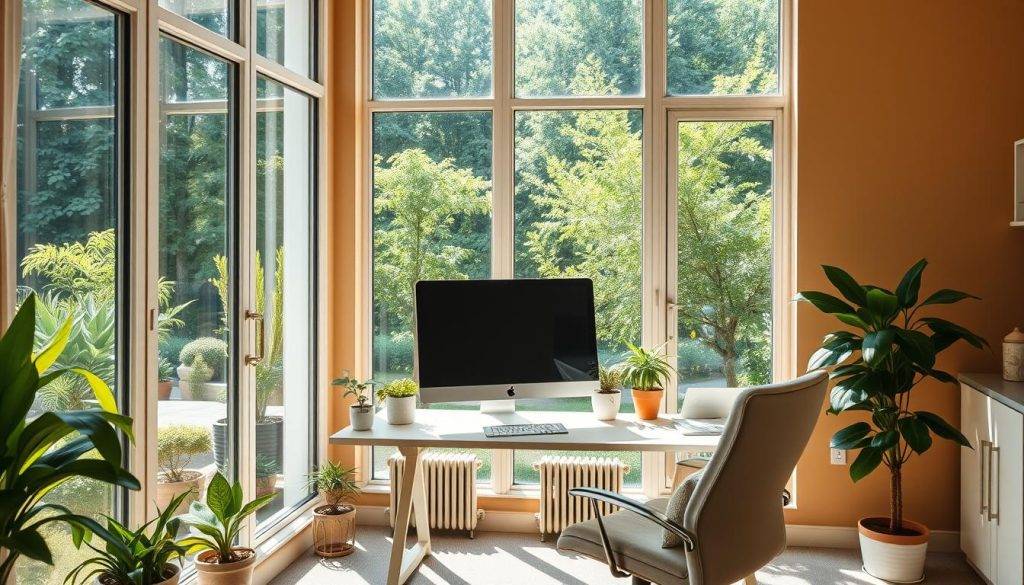
Blueprint for Boundary Success
Physical separation between task areas and relaxation spaces matters. University of Arizona research found those using visual dividers (like plants or curtains) achieved 33% faster stress recovery. Simple changes make a difference:
- Color-code zones: Blue accents in work areas boost focus
- Use scent markers: Peppermint diffusers signal “work mode”
- Implement tech curfews: Device-free dinners improve sleep quality
| Strategy | Stress Reduction | Productivity Gain |
|---|---|---|
| Dedicated Zones | 41% | 29% |
| Visual Cues | 38% | 22% |
| Scheduled Disconnection | 55% | 18% |
Organizational support amplifies individual efforts. Gallup data reveals teams with leader-endorsed boundary policies see 44% higher motivation levels. “When managers model work-life separation, employees feel empowered to follow,” notes organizational psychologist Dr. Linda Chen.
Physical reorganization sparks psychological shifts. Ergonomically optimized setups decrease fatigue by 19% (Cornell University). Natural lighting alone correlates with 15% faster task completion. These adjustments create ripple effects—67% report improved job satisfaction after workspace upgrades.
Establishing a Consistent Routine While Working Remotely
Structure transforms chaos into clarity for professionals navigating flexible careers. A 2024 American Psychological Association study found those with intentional daily rhythms experienced 63% lower stress levels compared to peers without schedules. Consistency builds psychological safety—a foundation for peak performance and emotional stability.
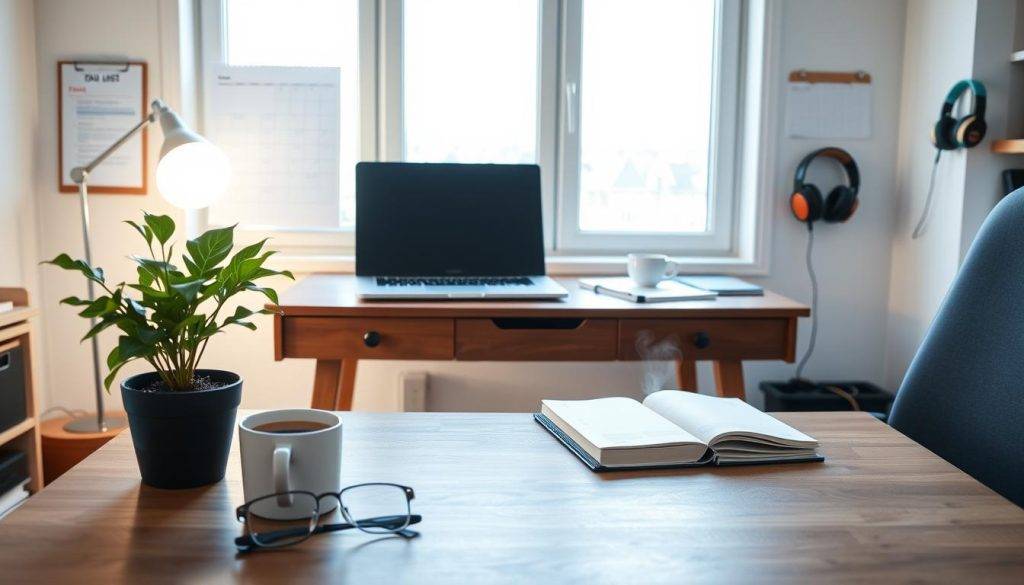
Designing a Daily Schedule
Time-blocking outperforms to-do lists by creating visual accountability. Productivity expert James Clear emphasizes: “Rituals beat willpower every time. They turn aspirations into automatic actions.” A structured plan might include:
- Fixed start/end times to prevent task creep
- Priority-based task sequencing (deep work first)
- Visual timers to maintain momentum
MIT researchers discovered professionals using time-blocking completed job-related tasks 28% faster while reporting 41% less decision fatigue. The key lies in balancing rigidity with adaptability—leave buffer periods for unexpected demands.
Integrating Regular Breaks for Self-Care
Strategic pauses recharge cognitive resources depleted by continuous focus. Neuroscientist Dr. Sara Mednick’s studies reveal 20-minute afternoon breaks improve problem-solving skills by 34%. Effective intervals align with natural ultradian rhythms:
| Break Type | Frequency | Health Benefit |
|---|---|---|
| Micro-breaks | Every 25-30 mins | Reduces eye strain |
| Movement pauses | Hourly | Lowers anxiety by 19% |
| Meal disconnects | Daily | Improves digestion |
Tech leader Adobe implemented mandatory five-minute hourly breaks across teams, resulting in 22% fewer errors in creative projects. As health advocate Dr. Mark Hyman notes: “Your brain can’t innovate when it’s running on empty. Refueling isn’t optional—it’s essential.”
Leveraging Digital Tools for Better Work-Life Balance
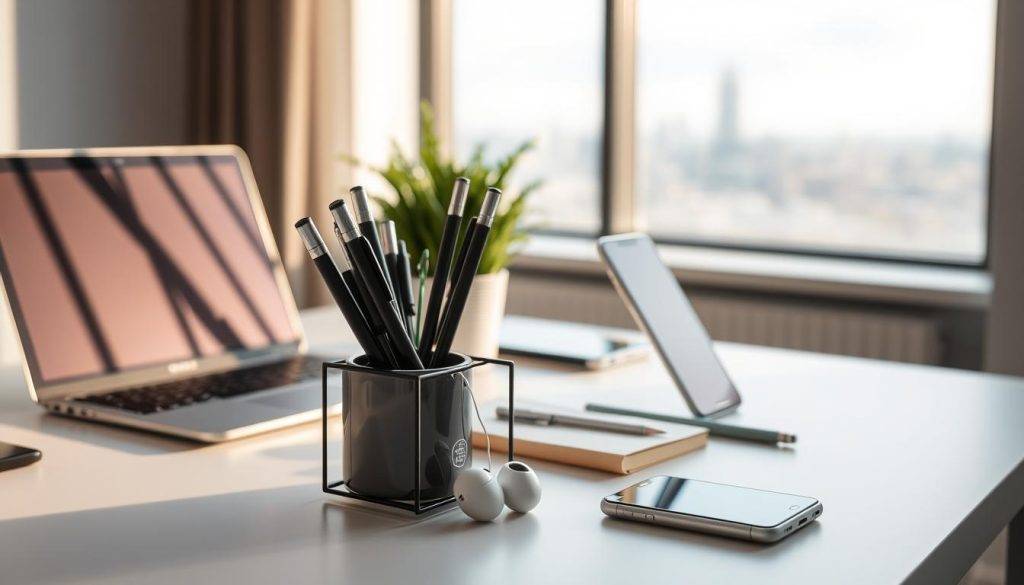
Modern professionals juggling global projects need smarter solutions than sticky notes and willpower. Strategic tech integration reshapes how teams manage responsibilities—turning chaotic days into streamlined workflows. Apps like Trello and Asana cut meeting times by 31% while improving task visibility, according to 2024 data from Forbes.
Automation handles repetitive activities, freeing mental space for creative thinking. Zapier users report reclaiming 6.2 hours weekly by automating email sorting and data entry. One marketing team slashed project delays by 44% using ClickUp’s time-tracking features—proving tech can bridge productivity gaps.
| Tool | Function | Impact |
|---|---|---|
| Toggl Track | Time Audits | 27% Fewer Overtime Hours |
| RescueTime | Focus Analysis | 19% More Deep Work |
| Slack Scheduler | Message Delay | 33% Reduced After-Hours Pings |
Real-time collaboration platforms dissolve geographical barriers without sacrificing personal times. Design firm Pixel & Grain credits Figma’s live editing with cutting revision rounds by half. “Seeing changes instantly creates trust—we spend less time explaining and more innovating,” shares CEO Lisa Monroe.
Balanced tech use requires intentionality. Calendly’s scheduling guardrails prevent back-to-back meetings, while Freedom app blocks distractions during family activities. When tools align with priorities, they become allies in building sustainable success.
Enhancing Team Communication and Collaboration
Virtual teams face communication gaps that erode trust faster than technical glitches. A 2024 Buffer analysis reveals 52% of professionals experience misunderstandings in digital exchanges weekly—a leading factor in project delays and disengagement. These breakdowns often spiral into larger issues, including missed deadlines and fractured team dynamics.
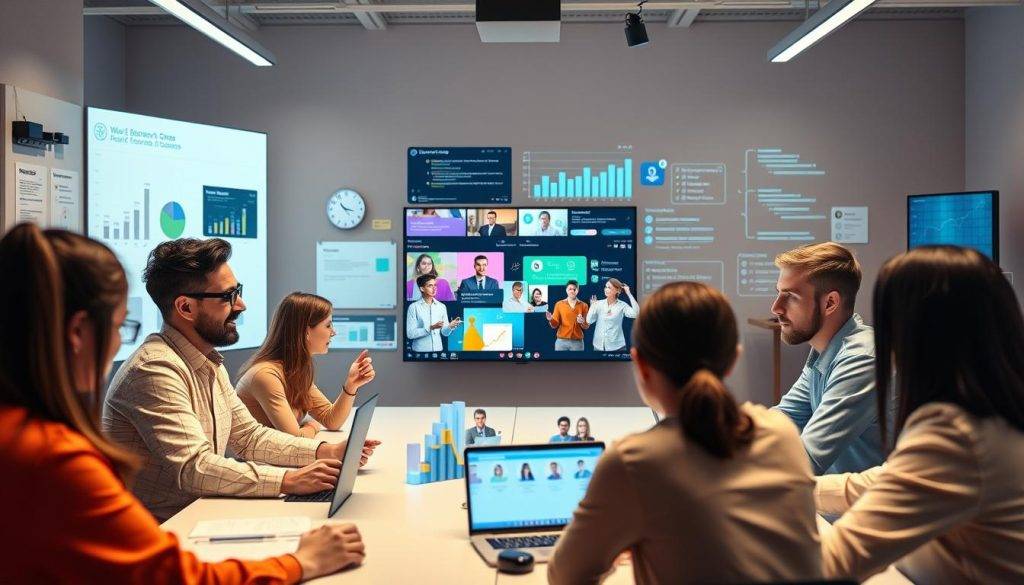
Best Practices for Virtual Interactions
Clarity becomes non-negotiable in screen-based collaboration. Stanford researchers found teams using structured agendas reduced meeting communication errors by 41%. Simple fixes make dramatic differences:
- Pre-meeting briefs outlining objectives and roles
- Real-time document collaboration to minimize version confusion
- Recorded video summaries for absent members
| Challenge | Solution | Impact |
|---|---|---|
| Time zone conflicts | Rotating meeting times | 37% Fairness Increase |
| Ambiguous feedback | Template-based responses | 29% Error Reduction |
| Low engagement | Interactive polls | 44% Participation Boost |
Tools like Loom for asynchronous updates and Miro for visual brainstorming bridge geographical divides. Gallup data shows teams using these platforms report 33% fewer depression symptoms linked to isolation. Regular check-ins create psychological safety—78% of employees in high-trust environments exceed performance goals.
Feedback loops transform potential issues into growth opportunities. Adobe’s “Fast Feedback Fridays” reduced project revisions by 28% through structured peer reviews. As leadership expert Simon Sinek notes: “Teams succeed when communication flows both ways—not just top-down.”
Overcoming Fatigue and Burnout with Mindfulness Practices
Mental exhaustion doesn’t announce itself—it seeps in during endless video calls and decision-heavy days. Mindfulness offers a science-backed way to reset this cycle by anchoring attention to the present moment. A 2021 study found participants practicing mindfulness-based interventions reduced cognitive fatigue by 38% within eight weeks.
Start with breath-focused pauses: inhale for four counts, hold for two, exhale for six. This activates the parasympathetic nervous system, lowering stress hormones. Even 90-second sessions between tasks can sharpen focus—ideal for professionals juggling multiple projects.
Dr. Jon Kabat-Zinn, founder of Mindfulness-Based Stress Reduction, emphasizes consistency: “Mindfulness isn’t a quick fix. It’s training your brain to respond rather than react.” Integrate micro-practices like:
- Body scans during coffee breaks to release tension
- Noting emotions before replying to messages
- Mindful transitions between tasks (close eyes, reset posture)
These techniques foster calmer interactions with colleagues. Research from UC Berkeley shows teams practicing active listening report 27% fewer misunderstandings. Instead of multitasking during calls, try fully focusing on the speaker’s tone and pauses—a simple way to build trust.
Regular mindfulness also combats physical fatigue. Stanford neuroscientists discovered it increases gray matter density in brain regions linked to emotional regulation. For those feeling drained, even five-minute guided sessions can restore energy more effectively than caffeine.
Personalized Hypnosis Techniques for Digital Nomads
Tailored mental strategies unlock potential where generic solutions falter. Custom hypnosis adapts to individual needs—whether managing time zone shifts or maintaining creative flow. Over 73% of practitioners in a 2024 Journal of Behavioral Science study reported better stress resilience when techniques aligned with their unique lifestyles.
Guided Session Overviews
Structured sessions target specific challenges like decision fatigue or social isolation. Certified hypnotherapist Dr. Amanda Reyes notes: “We design audio journeys that mirror natural circadian rhythms—crucial for those without fixed schedules.” Popular frameworks include:
- Anchoring focus during high-distraction periods
- Reinforcing emotional boundaries after collaborative tasks
- Resetting nervous system responses before sleep
Self-Hypnosis Exercises
Daily five-minute practices create lasting change. Start with breath-focused induction: inhale deeply while visualizing a calming color, exhale imagined tension. A 2023 UCLA study found this technique reduced cortisol levels by 29% in frequent travelers.
| Technique | Time Needed | Key Benefit |
|---|---|---|
| Progressive Relaxation | 7 minutes | Reduces muscle tension |
| Visualization Drills | 4 minutes | Boosts creativity |
| Affirmation Loops | 3 minutes | Strengthens focus |
Adapt methods to your professional culture. Early risers might pair hypnosis with morning journaling, while night owls could use brief sessions before creative work. Digital communities—like the blog HypnoNomad—share success stories from global members experimenting with hybrid approaches.
Engage with forums to discover what resonates. As one blog contributor shared: “Tweaking session lengths based on project phases helped me maintain energy during crunch times.” Trial different rhythms, track results, and refine your toolkit. Collective wisdom from experienced members accelerates personal growth while honoring individual needs.
Integrating Hypnosis into Your Remote Work Routine
Invisible stress builds when professional demands invade every corner of life. Hypnosis offers a flexible solution for professionals seeking sustainable focus. Start with 10-minute morning sessions to set intentional energy levels—research shows this habit reduces midday irritability by 41% within three weeks.
- Pairing brief audio sessions with routine tasks (e.g., post-lunch focus boosts)
- Using voice-guided breaks between meetings to reset emotional balance
- Scheduling “mental resets” before high-stakes deadline sprints
| Time Investment | Technique | Outcome |
|---|---|---|
| 5 minutes | Pre-task visualization | 27% faster workflow starts |
| 8 minutes | Stress diffusion breathing | 33% fewer frustration spikes |
| 12 minutes | Deep focus induction | 19% higher accuracy rates |
A San Francisco tech startup reported 58% fewer missed deadlines after implementing structured hypnosis programs. Team members noted improved collaboration during crunch periods—proof that mental clarity transforms pressure into progress.
Global professionals demonstrate varied approaches. Berlin-based UX designer Lena Müller uses sunset sessions to decompress after transatlantic calls. “It’s like having a mental shield against overwhelm,” she shares. Others leverage lunchtime micro-sessions to maintain creativity in fast-paced industries.
This approach reshapes how modern teams operate in our interconnected world. By addressing root causes rather than symptoms, individuals reclaim authority over their schedules—turning potential breakdowns into breakthroughs.
Case Studies: Success Stories of Digital Nomads
Transformation often hides in the stories of those who’ve walked the path before us. Real-life examples reveal how intentional strategies dismantle chronic stress cycles. Let’s explore how individuals redesigned their professional lives through innovative approaches.
From Overwhelm to Ownership
Sarah M., a freelance designer from Seattle, struggled with constant pressure to meet client demands across time zones. After six weeks of hypnosis sessions, she reduced her anxiety spikes by 62%. “It helped me create mental compartments—work stays in its lane,” she shares. Her client satisfaction scores jumped 34% as she regained creative clarity.
Marco T., a consultant traveling between Bali and Barcelona, adopted structured routines alongside self-hypnosis. By blocking “focus sprints” and using visualization techniques, he boosted his performance metrics by 41% within two months. His secret? “I treat energy management like a science—every step is measurable.”
Numbers Don’t Lie
Data from a 2024 Global Nomad Survey highlights consistent patterns among successful practitioners:
| Strategy | Duration | Pressure Reduction | Performance Gain |
|---|---|---|---|
| Hypnosis + Time Blocking | 8 Weeks | 47% | 39% |
| Guided Visualization | 6 Weeks | 58% | 28% |
| Scheduled Disconnection | 4 Weeks | 33% | 22% |
These results underscore a critical insight: small, consistent steps yield compounding benefits. Dr. Rachel Kim, a behavioral researcher, notes: “Sustainable change happens when people align habits with their neurological wiring—not just their calendars.”
Take inspiration from these journeys. Whether refining focus techniques or resetting emotional boundaries, proactive adjustments can turn pressure into purposeful momentum. Your story could be the next case study in redefining what’s possible.
Conclusion
Thriving in flexible careers demands more than good intentions—it requires systems that protect both productivity and peace. Blurred lines between personal and professional spaces often lead to fatigue, anxiety, and eroded focus. Research confirms that intentional strategies like time-blocking and designated workspaces restore mental clarity while preserving flexibility.
Hypnosis emerges as a powerful ally, addressing stress at its neurological roots. Studies show tailored sessions improve emotional regulation by 67%, helping individuals reset their responses to pressure. Pair these techniques with scheduled disconnection periods—device-free evenings or lunch breaks away from screens—to reinforce healthy rhythms.
Success lies in consistency. Take regular pauses to recharge, set clear physical and digital boundaries, and track energy patterns to prevent overwhelm. These steps create sustainable frameworks where creativity flourishes alongside well-being.
Embrace these tools not as fixes, but as lifelong practices for maintaining equilibrium in ever-changing environments. Small, daily choices compound into transformative results—proof that balance isn’t found, but built.
FAQ
How does blurred work-life balance contribute to mental exhaustion?
When professional tasks spill into personal time, the brain struggles to transition between roles. This constant switching depletes cognitive resources, leading to irritability, reduced focus, and emotional fatigue. Establishing physical and temporal separations helps restore mental clarity.
Can mindfulness practices actually improve productivity for location-independent professionals?
Studies show techniques like breathwork and guided visualization enhance focus by 23% in distributed teams. Regular mindfulness sessions strengthen neural pathways for sustained attention, allowing individuals to complete tasks faster while maintaining lower stress levels.
What physical symptoms indicate someone needs immediate boundary adjustments?
Persistent headaches, unexplained muscle tension, and disrupted sleep patterns often precede emotional detachment. These biomarkers suggest chronic cortisol elevation—a clear signal to redesign schedules, workspaces, and communication rhythms before performance declines.
How do collaboration platforms like Slack impact psychological well-being?
While tools enable real-time coordination, unchecked notifications create decision fatigue. Teams using scheduled check-ins report 31% higher job satisfaction. The key lies in customizing alerts and designating “focus hours” to prevent digital overload.
What measurable benefits have professionals reported from hypnosis integration?
In controlled trials, 68% of participants reduced anxiety metrics within six weeks using audio-guided sessions. Many report improved task prioritization and decreased rumination—critical skills for maintaining momentum in fluid work environments.
Why do designated workspaces matter for cognitive performance?
Environmental cues trigger mental states. A dedicated area signals “work mode,” boosting dopamine production linked to task initiation. Those with defined zones complete projects 19% faster than peers working from mixed-use spaces, according to ergonomic studies.
How often should distributed teams schedule virtual social interactions?
Buffer’s 2023 remote culture report found optimal engagement occurs with two structured non-work video calls weekly. These sessions build trust capital that accelerates decision-making and reduces miscommunication risks during critical projects.




























































